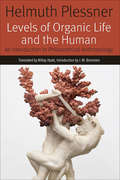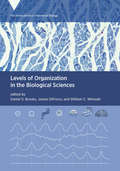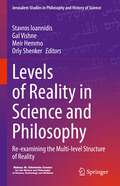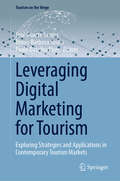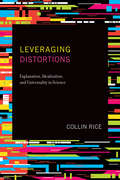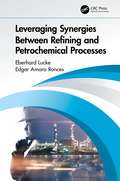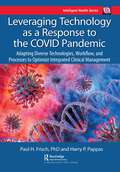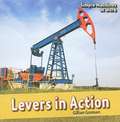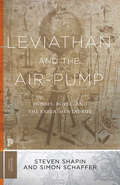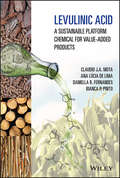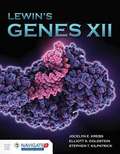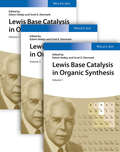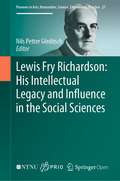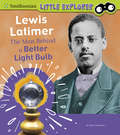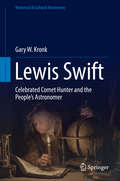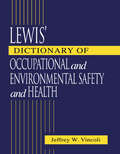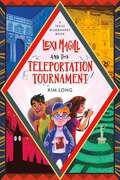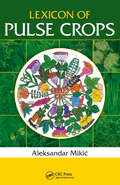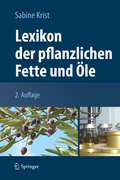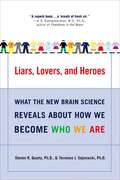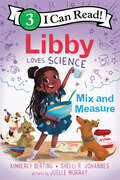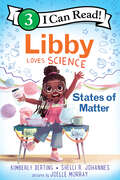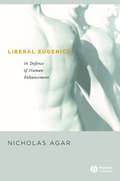- Table View
- List View
Levels of Organic Life and the Human: An Introduction to Philosophical Anthropology (Forms of Living)
by Helmuth PlessnerThe most important work by a key figure in German thought, Helmuth Plessner’s Levels of Organic Life and the Human, originally published in 1928, appears here for the first time in English, accompanied by a substantial Introduction by J. M. Bernstein, after having served for decades as an influence on thinkers as diverse as Merleau-Ponty, Peter Berger, Habermas, and the new naturalists.The Levels, as it has long been known, draws on phenomenological, biological, and social scientific sources as part of a systematic account of nature, life, and human existence. The book considers non-living nature, plants, non-human animals, and human beings in turn as a sequence of increasingly complex modes of boundary dynamics—simply put, interactions between a thing’s insides and surrounding world. On Plessner’s unique account, living things are classed and analyzed by their “positionality,” or orientation to and within an environment. “Life” is thereby phenomenologically defined, and its universal yet internally variable features such as metabolism, reproduction, and death are explained.The approach provides a foundation not only for philosophical biology but philosophical anthropology as well. According to Plessner’s radical view, the human form of life is excentric—that is, the relation between body and environment is something to which humans themselves are positioned and can take a position. This “excentric positionality” enables human beings to take a stand outside the boundaries of their own body, a possibility with significant implications for knowledge, culture, religion, and technology.Plessner studied zoology and philosophy with Hans Driesch in the 1910s before embarking on a highly productive philosophical career. His work was initially obscured by the superficially similar views of Max Scheler and Martin Heidegger and by his forced exile during World War II. Only in recent decades, as scholarship has moved more squarely into engagement with issues like animality, embodiment, human dignity, social theory, the philosophy of technology, and the philosophy of nature, has the originality and depth of Plessner’s vision been appreciated.A powerful and sophisticated account of embodiment, the Levels shows, with reference both to science and to philosophy, how life can be seen on its own terms to establish its own boundaries, and how, from the standpoint of life, the human establishes itself in relation to the nonhuman. As such, the book is not merely a historical monument but a source for invigorating a range of vital current conversations around the animal, posthumanism, the material turn, and the biology and sociology of cognition.This modern philosophical classic, long-awaited in English translation, is a key book both historically and for today’s interest in understanding philosophy and social theory together with science, without reducing the former to the latter.
Levels of Organization in the Biological Sciences (Vienna Series in Theoretical Biology)
by Daniel S. Brooks, James DiFrisco, and William C. WimsattScientific philosophers examine the nature and significance of levels of organization, a core structural principle in the biological sciences.This volume examines the idea of levels of organization as a distinct object of investigation, considering its merits as a core organizational principle for the scientific image of the natural world. It approaches levels of organization--roughly, the idea that the natural world is segregated into part-whole relationships of increasing spatiotemporal scale and complexity--in terms of its roles in scientific reasoning as a dynamic, open-ended idea capable of performing multiple overlapping functions in distinct empirical settings.The contributors--scientific philosophers with longstanding ties to the biological sciences--discuss topics including the philosophical and scientific contexts for an inquiry into levels; whether the concept can actually deliver on its organizational promises; the role of levels in the development and evolution of complex systems; conditional independence and downward causation; and the extension of the concept into the sociocultural realm. Taken together, the contributions embrace the diverse usages of the term as aspects of the big picture of levels of organization.ContributorsJan Baedke, Robert W. Batterman, Daniel S. Brooks, James DiFrisco, Markus I. Eronen, Carl Gillett, Sara Green, James Griesemer, Alan C. Love, Angela Potochnik, Thomas Reydon, Ilya Tëmkin, Jon Umerez, William C. Wimsatt, James Woodward
Levels of Reality in Science and Philosophy: Re-examining the Multi-level Structure of Reality (Jerusalem Studies in Philosophy and History of Science)
by Meir Hemmo Orly Shenker Stavros Ioannidis Gal VishneThis book offers a unique perspective on one of the deepest questions about the world we live in: is reality multi-leveled, or can everything be reduced to some fundamental ‘flat’ level? This deep philosophical issue has widespread implications in philosophy, since it is fundamental to how we understand the world and the basic entities in it. Both the notion of ‘levels’ within science and their ontological implications are issues that are underexplored in the philosophical literature. The volume reconsiders the view that reality contains many levels and opens new ways to understand the ontological status of the special sciences. The book focuses on major open questions that arise at the foundations of cognitive science, cognitive psychology, brain science and other special sciences, in particular with respect to the physical foundations of these sciences. For example: Is the mental computational? Do brains compute? How can the special sciences be autonomous from physics, grounded in, or based on, physics and at the same time irreducible to physics? The book is an important read for scientists and philosophers alike. It is of interest to philosophers of science, philosophers of mind and biology interested in the notion of levels, but also to psychologists, cognitive scientists and neuroscientists investigating such issues as the precise relation of the mental to the underlying neural structures and the appropriate approach to study it.
Leveraging Digital Marketing for Tourism: Exploring Strategies and Applications in Contemporary Tourism Markets (Tourism on the Verge)
by Bruno Barbosa Sousa José Duarte Santos Paulo Botelho PiresThis edited volume invites readers to explore the convergence of tourism and digital marketing. It navigates the intricate relationship between these two domains by elucidating the role of digital marketing across various facets of the tourism industry. Each chapter offers a blend of theoretical foundations and practical insights, delving into typologies of tourism, specific segments of tourists, and critical sectors essential to tourism's functionality. Through neutral, third-person narration, the volume presents a comprehensive examination, showcasing how digital marketing strategies are applied within diverse tourism contexts. Rich with examples illustrating theory in practice, this work serves as an essential resource for scholars, researchers, and professionals seeking a deeper understanding of this evolving landscape.
Leveraging Distortions: Explanation, Idealization, and Universality in Science
by Collin RiceAn examination of how scientists deliberately and justifiably use pervasive distortions of relevant features to explain and understand natural phenomena.A fundamental rule of logic is that in order for an argument to provide good reasons for its conclusion, the premises of the argument must be true. In this book, Collin Rice shows how the practice of science repeatedly, pervasively, and deliberately violates this principle. Rice argues that scientists strategically use distortions that misrepresent relevant features of natural phenomena in order to explain and understand--and that they use these distortions deliberately and justifiably in order to discover truths that would be otherwise inaccessible. Countering the standard emphasis on causation, accurate representation, and decomposition of science into its accurate and inaccurate parts, Rice shows that science's epistemic achievements can still be factive despite their being produced through the use of holistically distorted scientific representations. Indeed, he argues, this distortion is one of the most widely employed and fruitful tools used in scientific theorizing. Marshalling a range of case studies, Rice contends that many explanations in science are noncausal, and he presents an alternate view of explanation that captures the variety of noncausal explanations found across the sciences. He proposes an alternative holistic distortion view of idealized models, connecting it to physicists' concept of a universality class; shows how universality classes can overcome some of the challenges of multiscale modeling; and offers accounts of explanation, idealization, modeling, and understanding.
Leveraging Synergies Between Refining and Petrochemical Processes
by Eberhard Lucke Edgar Amaro RoncesLeveraging Synergies Between Refining and Petrochemical Processes provides a detailed description of the interfaces and connections between crude oil refining and petrochemicals. It offers a view of global and regional markets and economic opportunities for synergies between these sectors. Features: Shows a global and regional market outlook for crude oil refining and petrochemical sectors Explores economic and market opportunities for taking advantage of the synergies between both sectors Analyzes the technical challenges and opportunities that come with these synergies Gives an outlook and prediction of what companies will be able to achieve in the mid-term future Provides introductory and explanatory material as well as in-depth insight into future technology and market developments This book serves as a reference for professionals in chemical engineering, oil and gas engineering, and industrial chemistry. It aims to help engineers and industry professionals understand the challenges and the potential benefits of developing expansion or optimization projects that may bridge the gap between refining and petrochemicals.
Leveraging Technology as a Response to the COVID Pandemic: Adapting Diverse Technologies, Workflow, and Processes to Optimize Integrated Clinical Management (Intelligent Health Series)
by Harry P. Pappas Paul H. FrischIn 2019 the world was struck with the Coronavirus (COVID-19) infecting major portions of the world’s population. There were no vaccines or treatments available to help mitigate the disease or offer a cure. The world's health systems were inundated with massive numbers of patients with varying ranges of symptoms, acuity, and levels of criticality. The world's healthcare organizations soon found themselves in an unmanageable situation, directly impacting the ability to manage patients across the entire healthcare environment. Most healthcare institutions had plans for emergency preparedness and procedures to deal with temporary crises, none of which were effective against the impact of COVID-19. COVID-19 was a highly contagious disease, resulting in high volumes of admissions with long lengths of stay. The virus quickly overwhelmed institutions with large patient volumes, resulting in shortages of patient beds, medical equipment, personal protective devices, cleaning agents, and other critical supplies. Hospital operations were further impacted by staff shortages due to exposure, resulting contagion, the shutdown of transit systems, and responsibilities at home due to school and business closures. This timely and important book describes the impact on the hospital ability to provide patient care and how healthcare institutions leveraged diverse technology solutions to combat the impact of COVID-19 on providing patient care. The authors also discuss implementation of these technology solutions and the many lessons learned of how healthcare institutions can enhance their emergency preparedness in the future from the COVID experience. The authors would like to acknowledge, thank, and dedicate this book to the hundreds of thousands of healthcare workers around the world who spent countless hours and put their own lives and families lives at risk to help patients though this pandemic.
Levers In Action (Simple Machines at Work)
by Gillian GosmanLevers are everywhere. Readers will learn about historical and present-day uses of levers and how levers make countless everyday activities much easier. A simple experiment is included with step-by-step instructions.
Levers and Pulleys: FOSS Science Stories
by University of California at Berkeley Lawrence Hall of ScienceNIMAC-sourced textbook
Leviathan and the Air-Pump: Hobbes, Boyle, and the Experimental Life (Princeton Classics #32)
by Steven Shapin Simon SchafferLeviathan and the Air-Pump examines the conflicts over the value and propriety of experimental methods between two major seventeenth-century thinkers: Thomas Hobbes, author of the political treatise Leviathan and vehement critic of systematic experimentation in natural philosophy, and Robert Boyle, mechanical philosopher and owner of the newly invented air-pump. The issues at stake in their disputes ranged from the physical integrity of the air-pump to the intellectual integrity of the knowledge it might yield. Both Boyle and Hobbes were looking for ways of establishing knowledge that did not decay into ad hominem attacks and political division. Boyle proposed the experiment as cure. He argued that facts should be manufactured by machines like the air-pump so that gentlemen could witness the experiments and produce knowledge that everyone agreed on. Hobbes, by contrast, looked for natural law and viewed experiments as the artificial, unreliable products of an exclusive guild. The new approaches taken in Leviathan and the Air-Pump have been enormously influential on historical studies of science. Shapin and Schaffer found a moment of scientific revolution and showed how key scientific givens--facts, interpretations, experiment, truth--were fundamental to a new political order. Shapin and Schaffer were also innovative in their ethnographic approach. Attempting to understand the work habits, rituals, and social structures of a remote, unfamiliar group, they argued that politics were tied up in what scientists did, rather than what they said. Steven Shapin and Simon Schaffer use the confrontation between Hobbes and Boyle as a way of understanding what was at stake in the early history of scientific experimentation. They describe the protagonists' divergent views of natural knowledge, and situate the Hobbes-Boyle disputes within contemporary debates over the role of intellectuals in public life and the problems of social order and assent in Restoration England. In a new introduction, the authors describe how science and its social context were understood when this book was first published, and how the study of the history of science has changed since then.
Levulinic Acid: A Sustainable Platform Chemical for Value-Added Products
by Claudio J. Mota Ana Lúcia de Lima Daniella R. Fernandes Bianca P. PintoLEVULINIC ACID An essential overview of this renewable platform chemical with growing commercial applications Use of fossil fuels and their derivatives has been one of the major drivers of climate change. This ongoing crisis has driven a global search for biofuels and biomass-derived chemicals which can serve as the basis for sustainable and renewable industry. One such ‘platform molecule’ is levulinic acid, whose derivatives are increasingly replacing traditional fossil-derived chemicals. The importance of levulinic acid for renewable industry is therefore only growing. Levulinic Acid: A Sustainable Platform Chemical for Value-Added Products provides a book-length introduction to this chemical and its derivatives, like the levulinates, for which applications include fuel additives, food and cosmetic preservatives, flavors, solvents, and more. The book surveys the production routes and necessary technologies involved in the production of levulinic acid, as well as its current and potential applications and typical chemical reactions. It provides a critical introduction to a potentially rich source of alternative industrial material. Levulinic Acid readers will also find: Production routes from different biomass materials Treatment of both organic and inorganic levulinates Extensive discussion of levulinic acid hydrogenation Other derivatives formed upon reaction at the keto-functionality Levulinic Acid is the first book on this subject, ideal for researchers and industry professionals in green chemistry and sustainable/renewable production, as well as regulators and policymakers with a focus on the relevant industries.
Lewin’s Genes XII
by Jocelyn E. Krebs Elliott S. Goldstein Stephen T. KilpatrickLong considered the quintessential molecular biology textbook, for decades Lewin's GENES has provided the most modern presentation to this transformative and dynamic science. Now in its twelfth edition, this classic text continues to lead with new information and cutting-edge developments, covering gene structure, sequencing, organization, and expression. Leading scientists provide revisions and updates in their respective areas of study offering readers current research and relevant information on the rapidly changing subjects in molecular biology. No other text offers a broader understanding of this exciting and vital science or does so with higher quality art and illustrations. Lewin's GENES XII continues to be the clear choice for molecular biology and genetics.
Lewis Base Catalysis in Organic Synthesis, 3 Volume Set
by Denmark Edwin VedejsIntroductory Price £300 / 399 / $540, valid until December 31, 2016, thereafter £340 / 449 / $605This three-volume set represents the first comprehensive coverage of the rapidly expanding field of Lewis base catalysis that has attracted enormous attention in recent years. Lewis base catalysis is a conceptually novel paradigm that encompasses an extremely wide variety of preparatively useful transformations and is particularly effective for enantioselectively constructing new stereogenic centers. As electron-pair donors, Lewis bases can influence the rate and stereochemical course of myriad synthetic organic reactions. The book presents the conceptual/mechanistic principles that underlie Lewis base catalysis, and then builds upon that foundation with a thorough presentation of many different reaction types. And last but not least, the editors, Prof. Edwin Vedejs and Prof. Scott E. Denmark, are without doubt the leaders in this emerging field and have compiled high quality contributions from an impressive collection of international experts.
Lewis Fry Richardson: His Intellectual Legacy And Influence In The Social Sciences (Pioneers in Arts, Humanities, Science, Engineering, Practice #27)
by Nils Petter GleditschThis is an open access book. Lewis F Richardson (1981-1953), a physicist by training, was a pioneer in meteorology and peace research and remains a towering presence in both fields. This edited volume reviews his work and assesses its influence in the social sciences, notably his work on arms races and their consequences, mathematical models, the size distribution of wars, and geographical features of conflict. It contains brief bibliographies of his main publications and of articles and books written about Richardson and his work and discusses his continuing influence in peace research and international relations as well as his attitude to the ethical responsibilities of a scientist. It will be of interest to a wide range of scholars. This book includes 11 chapters written by Nils Petter Gleditsch, Dina A Zinnes, Ron Smith, Paul F Diehl, Kelly Kadera, Mark Crescenzi, Michael D Ward, Kristian Skrede Gleditsch, Nils B Weidmann, Jürgen Scheffran, Niall MacKay, Aaron Clauset, Michael Spagat and Stijn van Weezel.Lewis F Richardson occupied an important position in two academic fields as different as meteorology and peace research, with academic prizes awarded in both disciplines.In peace research, he pioneered the use of mathematical models and the meticulous compilation of databases for empirical research.As a quaker and pacifist, he refused to work in preparations for war, paid a heavy prize in terms of his career, and (at least in the social sciences) was fully recognized as a pioneering scholar only posthumously with the publication of two major books.Lewis Fry Richardson is one of the 20th century’s greatest but least appreciated thinkers—a creative physicist, psychologist, meteorologist, applied mathematician, historian, pacifist, statistician, and witty stylist. If you’ve heard of weather prediction, chaos, fractals, cliometrics, peace science, big data, thick tails, or black swans, then you have benefited from Richardson’s prescience in bringing unruly phenomena into the ambit of scientific understanding. Richardson’s ideas continue to be relevant today, and this collection is a superb retrospective on this brilliant and lovable man.Steven Pinker, Johnstone Professor, Harvard University, and the author of The Better Angels of Our Nature and Enlightenment Now
Lewis Latimer: The Man Behind a Better Light Bulb (Little Inventor)
by Nancy DickmannWhy is Lewis Latimer important? His invention of the carbon filament made light bulbs more afforable and longer lasting. Readers follow his journey from working with Alexander Graham Bell to improving Thomas Edison's light bulb. It's an enlightening story filled with engaging text and colorful images, all reviewed by Smithsonian experts.
Lewis Swift: Celebrated Comet Hunter and the People's Astronomer (Historical & Cultural Astronomy)
by Gary W. KronkThis biography covers the life of Lewis Swift (1820-1913), who discovered 13 comets and nearly 1,200 other deep sky objects. All 13 comets found by Swift now bear his name, including three periodic comets with periods of 6 years (11P/Tempel-Swift-LINEAR), 9 years (64P/Swift-Gehrels), and 133 years (109P/Swift-Tuttle).Swift's enthusiasm and success as an amateur astronomer helped make him famous in the United States. With the help of others, Swift was able to buy a 16-inch refractor, the third largest telescope in the United States at the time. Hulbert Harrington Warner built "Warner Observatory" to house this telescope. As a prolific writer and lecturer, Swift's stories appeared in newspapers and magazines, while his lectures showed that he was able to explain anything in a way that everyone could understand. When Warner went broke during the "Panic of 1893," Swift was forced to leave his home. Almost two dozen invitations arrived from around the United States asking him to bring his telescope to their city, and he eventually accepted the invitation of Californian Thaddeus Sobieski Constantin Lowe. This book highlights Swift's valuable contributions to astronomy before failing eyesight forced him to give up this profession. In addition to detailing Swift's life, biographical material is also provided for a number of individuals who were influenced by Swift. This includes his son, Edward, who was discovering deep sky objects as a teenager.
Lewis' Dictionary of Occupational and Environmental Safety and Health
by Jeffrey Wayne VincoliWith definitions from areas such as toxicology, industrial hygiene, environmental compliance, environmental engineering, and occupational medicine the Lewis Dictionary of Occupational and Environmental Safety and Health contains THE MOST definitions for the words, related phrases, and terms encountered in these fields. It also includes a comprehens
Lexi Magill and the Teleportation Tournament
by Kim LongFor fans of The Amazing Race, Lexi Magill and the Teleportation Tournament is the perfect adventure for middle grade readers who like scavenger hunts and puzzle-solving.Twelve-year-old physics whiz Lexi Magill won't let anything stop her from winning Wisconsin's Teleportation Tournament--the annual competition where teams teleport around the world to solve science-based puzzles. She needs the prize money if she wants to re-enroll in the science academy her parents can no longer afford. Added bonus: she'll be able to reconnect with her best friend Haley.But Lexi's two teammates put a wrench in her plans. When one misreads a clue that lands the team in a castle in Germany, and the other loses her teleportation medallion in Poland, Lexi wonders what she's gotten herself into. Struggling to keep her team under control as the race rages on, Lexi not only has to figure out how to get back on course (literally), but she must decide how far she's willing to go to win, and who her real friends are. With riddles to solve and messages to decode, this interactive read won't disappoint!
Lexicon of Pulse Crops
by Aleksandar MikićLexicon of Pulse Crops integrates botanical and linguistic data to analyze and interpret the grain legume significance from the earliest archaeological and written records until the present day. Aimed at both agronomic and linguistic research communities, this book presents a database containing 9,500 common names in more than 900 languages and dialects of all ethnolinguistic families, denoting more than 1,100 botanical taxa of 14 selected pulse crop genera and species. The book begins with overviews of the world’s economically most important grain legume crops and their uncultivated relatives, as well as the world’s language families with their inner structure, including both extinct and living members. The main section of the text presents 14 specialized book chapters covering Arachis, Cajanus, Cicer, Ervum, Faba, Glycine, Lablab, Lathyrus, Lens, Lupinus, Phaseolus, Pisum, Vicia, and Vigna. They provide the reader with extensive lists of the botanically accepted species and subtaxa and surveys lexicological abundance in all world’s ethnolinguistic families, comprising extinct and living as well as natural and constructed languages, while the vernacular names for the most significant taxa are presented in comprehensive tables. Each of these chapters also presents the existing etymologies and novel approaches to deciphering the origins of common names, accompanied by one original color plate depicting possible root evolutions in the form of corresponding pulse crop plants.
Lexikon der Arzneipflanzen und Drogen
by Matthias F. Melzig Karl HillerDas Lexikon der Arzneipflanzen und Drogen gibt einen umfassenden Überblick über die heute wie auch in früherer Zeit verwendeten Arzneidrogen. Die 3. Auflage des Lexikons enthält ca. 480 neue Artikel inkl. Strukturformeln der Drogeninhaltsstoffe und wurde um das Gebiet der Nahrungsergänzungsmittel erweitert. In den einzelnen Artikeln wird auf Drogen europäischer Arzneibücher hingewiesen sowie auf solche, die in der europäischen, afrikanischen, amerikanischen oder asiatischen traditionellen Medizin eingesetzt werden. Die Anordnung der Stichwörter erfolgt alphabetisch nach den wissenschaftlichen Namen der Pflanzen/Tiere/Mikroorganismen und beinhaltet Vorkommen bzw. Herkunft der Drogen, Inhaltsstoffe, therapeutische Nutzung bzw. Anwendung in der Volksheilkunde und Homöopathie. Als umfassendes Nachschlagewerk für alle Fragestellungen zu Arzneidrogen wendet sich das Lexikon an Wissenschaftler und Studenten der Pharmazie, Biologie, Medizin, Chemie sowie an Ärzte für Naturheilverfahren, Apotheker, Heilpraktiker und an Mitarbeiter in der Industrie.
Lexikon der pflanzlichen Fette und Öle
by Sabine KristAus naturwissenschaftlicher Sicht stellen die Autoren 135 bekannte und exotische Pflanzenöle, Wachse und pflanzliche Fette systematisch dar - darunter Kiwisamen-, Tomatenkern- und Ootangaöl. Besonderes Augenmerk gilt den Stammpflanzen, der Gewinnung, den Inhaltsstoffen sowie der ernährungsphysiologischen Zusammensetzung. Anwendungsmöglichkeiten in Medizin, Pharmazie, Kosmetik und Technik sowie mögliche Nebenwirkungen werden diskutiert. In die Neuauflage des Lexikons wurden 40 weitere Fette und Öle aufgenommen.
Liars, Lovers, and Heroes: What the New Brain Science Reveals About How We Become Who We Are
by Terrence J. Sejnowski Steven R. QuartzTwo neuroscientists share a cutting-edge thesis on how biology, culture, and the environment contribute to our impulses, behaviors, and selves.This book combines cutting-edge findings in neuroscience with examples from history and the headlines to introduce the new science of cultural biology, born of advances in brain imaging, computer modeling, and genetics. Doctors Quartz and Sejnowski show how both our noblest and darkest traits are rooted in brain systems so ancient that we share them with insects. They then demystify the dynamic engagement between brain and world that makes us something far beyond the sum of our parts.The authors show how our humanity unfolds through increasingly complex interactions between brain and world. They investigate shaping forces both ancient and contemporary, from thousands of years of climate change to the tragic events of September 11, 2001. And they offer intriguing answers to some of our most enduring questions, including why we live together, love, kill—and sometimes lay down our lives for others.
Libby Loves Science: Mix and Measure (I Can Read Level 3)
by Kimberly Derting Shelli R. JohannesLibby loves science! In this STEM-themed Level 3 I Can Read! title, Libby and her friend Rosa learn about mixing and measuring to bake a delicious treat for a puppy party. A great choice for aspiring scientists, emerging readers, and fans of Andrea Beaty’s Ada Twist, Scientist. Includes activities, a glossary, and a cupcake recipe. Libby loves science—and experimenting! In this Level 3 I Can Read! title, Libby hosts a puppy party for her friends and their dogs. With the help of her friend Rosa and little brother, Libby decorates, stuffs goody bags and bakes delicious cupcakes. But when they realize they’ve forgotten an important ingredient, they use science to solve the problem—just in the nick of time. The Loves Science books introduce readers to girls who love science, as well as basic concepts of science, technology, engineering, and math. This Level 3 I Can Read! focuses on basic chemistry and friendship. A great pick for newly independent readers and an ideal companion to Cece Loves Science: Push and Pull.
Libby Loves Science: States of Matter (I Can Read Level 3)
by Kimberly Derting Shelli R. JohannesLibby loves science! In this STEM-themed Level 3 I Can Read! title, Libby and her friends learn about solids, liquids, and gases. A great choice for aspiring scientists, new readers, and fans of Andrea Beaty’s Ada Twist, Scientist. Includes activities, a glossary, and a fun science experiment to do at home.Libby loves science—and experimenting! In this Level 3 I Can Read! title, Libby and her classmates are excited to welcome a new student into their classroom. When the ice cream for the welcome party melts, Libby is curious to see how the three states of matter can save the celebration. Experiment with Libby and find out!The Loves Science books introduce readers to girls who love science, as well as basic concepts of science, technology, engineering, and math. This Level 3 I Can Read! explores how solids, liquids, and gases are all around us, and includes two experiments to try at home or school, as well as a glossary. A great pick for newly independent readers and an ideal companion to Cece Loves Science: Push and Pull, Libby Loves Science: Mix and Measure, Vivi Loves Science: Sink or Float, and Vivi Loves Science: Wind and Water.
Liberal Eugenics: In Defence of Human Enhancement
by Nicholas AgarPublic debate about the use of genetic technology is dominated by fears of a Huxleyan 'Brave New World' or a return to the fascist eugenics of the past. In this controversial book, philosopher Nicholas Agar defuses these anxieties and defends the idea that parents should be allowed to enhance their children's genetic characteristics. Agar describes three technologies that may soon make liberal eugenics a practical possibility - cloning by somatic cell nuclear transfer, genomics, and genetic engineering - and argues that parents can use these technologies to realize their procreative goals without harming the people they will bring into existence. He rejects the idea that eugenics need divide society into genetic haves and have-nots, and denies that social pressures need force eugenic choices to converge on a single view of human excellence, suggesting that these threats to liberal social arrangements can be resisted.
